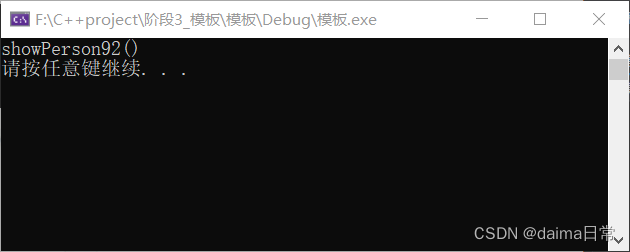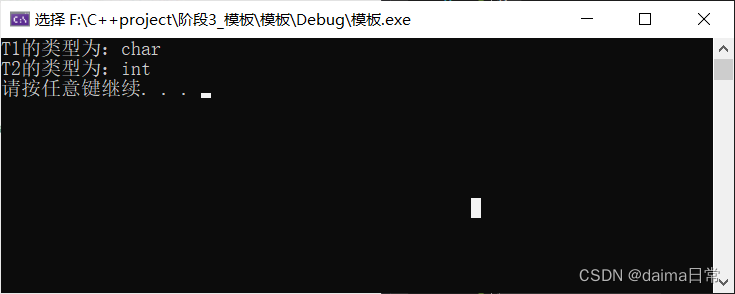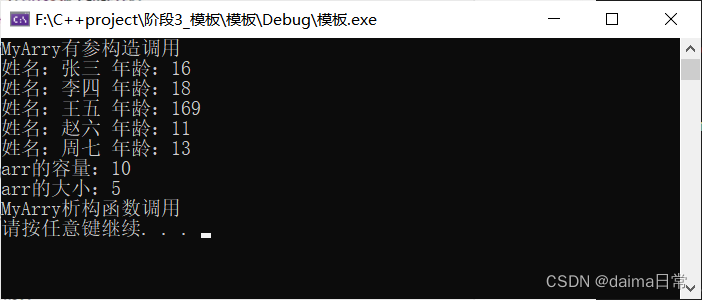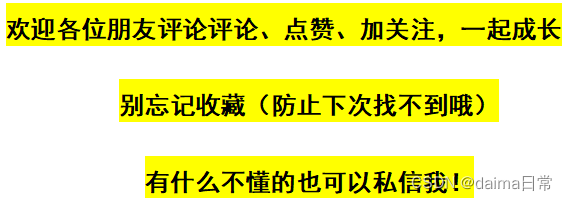文章目录
10.3 类模板
10.3.1 类模板
类模板作用:
- 建立一个通用类,类中的成员,数据类型可以不具体制定,用一个虚拟的类型来代表。
语法:
template<typename T>
类
解释:
template------------声明创建模板
typename ---------表明其后面的符号是一种数据类型,可以用class 代替
T --------- 通用的数据类型,名称可以替换,通常为大写字母
示例代码:
#include<iostream>
using namespace std;
#include<string>
//类模板
template<class NameType,class AgeType>
class Person
{
public:
Person(NameType name, AgeType age)
{
m_name = name;
m_age = age;
}
void showPerson()
{
cout << this->m_name << " " << this->m_age <<"岁"<< endl;
}
NameType m_name;
AgeType m_age;
};
void test71()
{
Person<string, int>p1("孙悟空", 99);
p1.showPerson();
}
int main()
{
test71();
system("pause");
return 0;
}
运行结果:

**总结:**类模板和函数模板语法相似,在声明模板template后面加类,此类称为类模板。
10.3.2 类模板与函数模板区别
类模糊与函数模板区别主要有两点:
- 类模板没有自动类型推导的使用方式
- 类模板在模板参数列表中可以有默认参数
示例代码:
#include<iostream>
using namespace std;
#include<string>
//类模板与函数模板区别
//template<class NameType,class AgeType>
template<class NameType,class AgeType=int> //在参数列表中指定参数AgeType默认类型为int
class Person7
{
public:
Person7(NameType name,AgeType age)
{
this->m_Name = name;
this->m_Age = age;
}
void showPerson7()
{
cout << this->m_Name << " " << this->m_Age << "岁" << endl;
}
NameType m_Name;
AgeType m_Age;
};
//1、类模板没有自动类型推导使用方式
void test81()
{
//Person7 p("孙悟空",100); 错误,无法用自动类型推导
Person7<string, int>p("孙悟空",100);//正确,只能用显示指定类型方式
p.showPerson7();
}
//2、类模板在模板参数列表中可以有默认参数
void test82()
{
Person7<string>p("猪八戒", 999);
p.showPerson7();
}
int main()
{
//test81();
test82();
system("pause");
return 0;
}
运行结果:

总结:
- 类模板使用只能用显示指定类型方式
- 类模板中的目标参数列表可以有默认参数
10.3.3 类模板中成员函数创建时机
类模板中成员函数和普通函数中成员函数创建时机是有区别的:
- 普通类中的成员函数一开始就可以创建
- 类模板中的成员函数在调用时才开始创建
示例代码:
#include<iostream>
using namespace std;
//类模板中成员函数创建时机
//类模板中成员函数在调用时才去创建
class Person91
{
public:
void showPerson91()
{
cout << "showPerson91()" << endl;
}
};
class Person92
{
public:
void showPerson92()
{
cout << "showPerson92()" << endl;
}
};
template<class T>
class MyClass
{
public:
T obj;
//类模板中的成员函数,并不是一开始就创建的,而是在模板调用时再生成
void func1()
{
obj.showPerson91();
}
void func2()
{
obj.showPerson92();
}
};
void test91()
{
MyClass<Person92>m;
//m.func1(); //编译会出错,什么函数调用才会去创建成员函数
m.func2();
}
int main()
{
test91();
system("pause");
return 0;
}
运行结果:

**总结:**类模板中的成员函数并不是一开始就创建的,而是在调用时才会创建。
10.3.4 类模板对象做函数参数
学习目标:
- 类模板实例化出的对象,向函数传参的方式
一共有三种传入方式:
- 指定传入的类型 ---- 直接显示对象的数据类型
- 参数模板化 -----将对象中的参数变为模板进行传递
- 整个模板 ----将这个对象类型模板化进行传递
示例代码:
#include<iostream>
using namespace std;
#include<string>
//类模板做函数参数
template<class TN,class TA>
class Person10
{
public:
Person10(TN name, TA age)
{
this->m_Name = name;
this->m_Age = age;
}
void showPerson10()
{
cout << "姓名:" << this->m_Name << " " << "年龄:" << this->m_Age << endl;
}
TN m_Name;
TA m_Age;
};
//1、指定传入类型
void printPerson1(Person10 <string, int >&p) //通过引用的方式传入
{
p.showPerson10();
}
void test101()
{
Person10 <string, int >p("孙悟空",9);
printPerson1(p);
}
//2、参数模板化
template<class T1,class T2>
void printPerson2(Person10<T1, T2>&p)
{
p.showPerson10();
//打印T1和T2的数据类型
cout << "T1的类型为:" << typeid(T1).name() << endl;
cout << "T2的类型为:" << typeid(T2).name() << endl;
}
void test102()
{
Person10<string, int>p("小猪猪", 8);
printPerson2(p);
}
//3、整个类模板化
template<class T>
void printPerson3( T &p)
{
p.showPerson10();
//打印T所代表的数据类型
cout << "T的数据类型为:" << typeid(T).name() << endl;
}
void test103()
{
Person10<string, int>p("唐憎",10);
printPerson3(p);
}
int main()
{
//test101();
//test102();
test103();
system("pause");
return 0;
}
运行结果:

总结:
- 通过类模板创建的对象,可以有三种方式向函数中进行传参
- 使用比较广泛的是第一种:指定传入的类型
10.3.5 类模板与继承
当类模板碰到继承时,需要注意以下几点:
- 当子类继承的父类是一个类模板时,子类在声明的时候,要指定出父类中T的类型
- 如果不指定,编译器无法给子类分配内存
- 如果想灵活指定出父类中T的类型,子类也需变为类模板
示例代码:
#include<iostream>
using namespace std;
//类模板与继承
template<class T>
class Base
{
public:
T m;
};
//class Son :public Base //错误,必须知道父类中T的类型,才能继承给子类
class Son:public Base<int>
{
};
void test11()
{
Son s1;
}
//如果想灵活指定父类中T类型,子类也需要变为类模板
template<class T1, class T2>
class Son2 :public Base<T1>
{
public:
Son2()
{
cout << "T1的类型为:" << typeid(T1).name() << endl;
cout << "T2的类型为:" << typeid(T2).name() << endl;
}
T2 obj;
};
void test112()
{
Son2 <char, int>s2;
}
int main()
{
//test11();
test112();
system("pause");
return 0;
}
运行结果:

**总结:**如果父类是类模板,子类需要指定出父类中T的数据类型
10.3.6 类模板成员函数类外实现
学习目标:能够掌握类模板中的成员函数类外实现
示例代码:
#include<iostream>
using namespace std;
#include<string>
//类模板成员函数类外实现
template<class T1,class T2>
class Person12
{
public:
Person12(T1 name, T2 age);
//{
// m_Name = name;
// m_Age = age;
//}
void showPerson12();
//{
// cout << "姓名:" << thiis->m_Name << " " << "年龄:" << this->m_Age << endl;
//}
T1 m_Name;
T2 m_Age;
};
//构造函数类外实现
template<class T1, class T2>
Person12<T1,T2>::Person12(T1 name, T2 age)
{
m_Name = name;
m_Age = age;
}
//类模板中成员函数类外实现
template<class T1, class T2>
void Person12<T1, T2>::showPerson12()
{
cout << "姓名:" << this->m_Name << " " << "年龄:" << this->m_Age << endl;
}
void test12()
{
Person12<string, int>P("Mr.liao", 22);
P.showPerson12();
}
int main()
{
test12();
system("pause");
return 0;
}
运行结果:

总结:;类模板中成员函数类外实现时,需要加上模板参数列表
10.3.7 类模板分文件编写
学习目标:
- 掌握类模板成员函数分文件编写产生的问题以及解决方式
问题:
- 类模板中成员函数创建时机是在调用阶段,导致分文件编写是连接不到
解决办法:
- 解决方式1:直接包含.cpp源文件
- 解决方式2:将声明和实现写到同一个文件中,并更改后缀名为.hpp,hpp是约定的名称,并不是强制。
示例代码:
person13.hpp文件
#pragma once
#include<iostream>
using namespace std;
#include<string>
//类模板分文件编写问题以及解决办法
template<class T1, class T2>
class Person13
{
public:
Person13(T1 name, T2 age);
void showPerson13();
T1 m_Name;
T2 m_Age;
};
//类模板的构造函数类外实现
template <class T1, class T2>
Person13<T1, T2>::Person13(T1 name, T2 age)
{
this->m_Name = name;
this->m_Age = age;
}
//类模板成员函数类外实现
template <class T1, class T2>
void Person13<T1, T2>::showPerson13()
{
cout << "姓名:" << this->m_Name << " " << "学号:" << this->m_Age << endl;
}
main.cpp文件
#include<iostream>
using namespace std;
//第一种解决方法直接包含源文件
//#include"person13.h"
//#include"person13.cpp"
//第二种解决办法,将.h和.cpp中的内容写到一起,将后缀名改为.hpp文件
#include"person13.hpp"
类模板分文件编写问题以及解决办法
//template<class T1,class T2>
//class Person13
//{
//public:
// Person13(T1 name, T2 age);
// void showPerson13();
//
// T1 m_Name;
// T2 m_Age;
//};
类模板的构造函数类外实现
//template <class T1,class T2>
//Person13<T1,T2>::Person13(T1 name, T2 age)
//{
// this->m_Name = name;
// this->m_Age = age;
//}
//类模板成员函数类外实现
//template <class T1, class T2>
//void Person13<T1, T2>::showPerson13()
//{
// cout << "姓名:" << this->m_Name << " " << "学号:" << this->m_Age << endl;
//}
void test13()
{
Person13<string, int>p("Mr.liao",22);
p.showPerson13();
}
int main()
{
test13();
system("pause");
return 0;
}
运行结果:

**总结:**主流的解决方式是第二种,将类模板成员函数写到一起,并将后缀名改成.hpp
10.3.8 类模板与友元
学习目标:
- 掌握类模板配合友元函数的类内和类外实现
全局函数类内实现 - 直接在类内声明友元即可
全局函数类外实现 - 需要提前让编译器知道全局函数的存在
示例代码:
#include<iostream>
using namespace std;
//提前让编译器知道Person类存在
template<class T1,class T2>
class Person14;
//2、全局函数类外实现
template<class T1, class T2>
void showPerson2(Person14<T1, T2>p)
{
cout << "姓名:" << p.m_Name << " " << "年龄:" << p.m_age << endl;
}
//通过全局函数 打印Person信息
template<class T1,class T2>
class Person14
{
//1、全局函数,类内实现
friend void showPerson1(Person14<T1, T2>p)
{
cout << "姓名:" << p.m_Name << " " << "年龄:" << p.m_age << endl;
}
//2、全局函数类外实现
//加空模板的参数列表
//如果全局函数是类外实现,需要让编译器提前知道这个函数的存在
friend void showPerson2<>(Person14<string, int>p);
public:
Person14(T1 name, T2 age)
{
this->m_Name = name;
this->m_age = age;
}
private:
T1 m_Name;
T2 m_age;
};
void test141()
{
Person14<string, int>p("Mr.liao",22);
showPerson1(p);
}
//2、全局函数在类外实现
void test142()
{
Person14<string, int>p2("Mr.xiong", 20);
showPerson2(p2);
}
int main()
{
//test141();
test142();
system("pause");
return 0;
}
运行结果:

**总结:**建议全局函数类内实现,用法简单,而编译器可以直接识别
10.3.9 类模板案例
案例描述:实现一个通用的数组类,要求如下:
- 可以对内置数组类型以及自定义数据类型进行存储
- 将数组中的数据存储到堆区
- 构造函数中可以传入数组的容量
- 提高对应的拷贝函数以及operator=防止浅拷贝问题
- 可以通过下标的方式访问数组中的元素
- 可以获取数组中当前元素个数和数组的容量
示例代码–第一阶段:
MyArry.hpp文件:
#pragma once
#include<iostream>
using namespace std;
//数组模板
template<class T>
class MyArry
{
public:
//有参构造 参数 容量
MyArry(int capacity)
{
cout << "MyArry有参构造调用" << endl;
this->m_Capacity = capacity;
this->m_Size = 0;
this->pAddress = new T[this->m_Capacity];
}
//拷贝构造
MyArry(const MyArry& arr)
{
cout << "MyArry拷贝构造调用" << endl;
this->m_Capacity = arr.m_Capacity;
this->m_Size = arr.m_Size;
//this->pAddress=arr.pAddress;
//深拷贝
this->pAddress = new T[arr.m_Capacity];
//将arr中的数据都拷贝过来
for (int i = 0; i < this->m_Size; i++)
{
this->pAddress[i] = arr.pAddress[i];
}
}
//operator = 防止浅拷贝问题
MyArry& operator=(const MyArry& arr)
{
cout << "MyArry的operator=调用" << endl;
//先判断原理堆区是否有数据,如果有先释放
if (this->pAddress != NULL)
{
delete[] this->pAddress;
this->pAddress = NULL;
this->m_Capacity = 0;
this->m_Size = 0;
}
//深拷贝,把数组中的所有数据多copy过来
this->m_Capacity = arr.m_Capacity;
this->m_Size = arr.m_Size;
for (int i = 0; i < this->m_Size; i++)
{
this->pAddress = new T[arr.pAddress[i]];
}
return *this;
}
//析构函数
~MyArry()
{
cout << "MyArry析构函数调用" << endl;
if (this->pAddress != NULL)
{
delete[] this->pAddress; //释放堆区数组的内存
this->pAddress = NULL; //将指针置空,防止野指针出现
}
}
private:
T* pAddress; // 指针指向堆区开辟的真实数组
int m_Capacity; ///数组的容量
int m_Size; //数组大小
};
main.c文件:
#include<iostream>
using namespace std;
#include"MyArry.hpp"
void test15()
{
MyArry<int>arr1(5);
MyArry<int>arr2(arr1);//测试拷贝构造
MyArry<int>arr3(100);
arr3 = arr1;
}
int main()
{
test15();
system("pause");
return 0;
}

大成篇:
MyArry.hpp
#pragma once
#include<iostream>
using namespace std;
//数组模板
template<class T>
class MyArry
{
public:
//有参构造 参数 容量
MyArry(int capacity)
{
cout << "MyArry有参构造调用" << endl;
this->m_Capacity = capacity;
this->m_Size = 0;
this->pAddress = new T[this->m_Capacity];
}
//拷贝构造
MyArry(const MyArry& arr)
{
cout << "MyArry拷贝构造调用" << endl;
this->m_Capacity = arr.m_Capacity;
this->m_Size = arr.m_Size;
//this->pAddress=arr.pAddress;
//深拷贝
this->pAddress = new T[arr.m_Capacity];
//将arr中的数据都拷贝过来
for (int i = 0; i < this->m_Size; i++)
{
this->pAddress[i] = arr.pAddress[i];
}
}
//operator = 防止浅拷贝问题
MyArry& operator=(const MyArry& arr)
{
cout << "MyArry的operator=调用" << endl;
//先判断原理堆区是否有数据,如果有先释放
if (this->pAddress != NULL)
{
delete[] this->pAddress;
this->pAddress = NULL;
this->m_Capacity = 0;
this->m_Size = 0;
}
//深拷贝,把数组中的所有数据多copy过来
this->m_Capacity = arr.m_Capacity;
this->m_Size = arr.m_Size;
for (int i = 0; i < this->m_Size; i++)
{
this->pAddress = new T[arr.pAddress[i]];
}
return *this;
}
//尾插法
void Push_Back(const T& val)
{
//判断人脸是否等于大小
if (this->m_Capacity == this->m_Size)
{
cout << "数组已满无法插入" << endl;
return;
}
this->pAddress[this->m_Size] = val; //在数组末尾插入数据
this->m_Size++;
}
//尾删法
void Pop_Back()
{
//让用户访问不到最后一个元素,即为尾删,逻辑删除
if (this->m_Size==0)
{
cout << "数组为空,无法删除!" << endl;
return;
}
//delete this->pAddress[this->m_Size];
//this->pAddress[this->m_Size] = NULL;
this->m_Size--;
}
//通过下标访问数组中的数据,要赋左值要返回引用而不是数值
T& operator[] (int index)
{
return this->pAddress[index];
}
//返回数组的大小
int getSize()
{
return this->m_Size;
}
//返回数组的容量
int getCapacity()
{
return this->m_Capacity;
}
//析构函数
~MyArry()
{
cout << "MyArry析构函数调用" << endl;
if (this->pAddress != NULL)
{
delete[] this->pAddress; //释放堆区数组的内存
this->pAddress = NULL; //将指针置空,防止野指针出现
}
}
private:
T* pAddress; // 指针指向堆区开辟的真实数组
int m_Capacity; ///数组的容量
int m_Size; //数组大小
};
main.c
#include<iostream>
using namespace std;
#include"MyArry.hpp"
//打印数组
void printIntArray(MyArry <int>& arr)
{
for (int i = 0; i < arr.getSize(); i++)
{
cout << arr[i] << endl;
}
}
void test15()
{
MyArry<int>arr1(5);
//MyArry<int>arr2(arr1);//测试拷贝构造
//MyArry<int>arr3(100);
//arr3 = arr1;
for (int i = 0; i < 5; i++)
{
arr1.Push_Back(i);
}
cout << "数组中的元素打印输出为:" << endl;
printIntArray(arr1);
cout << "arr1容量为:" <<arr1.getCapacity() <<endl;
cout << "arr1目前大小为:" <<arr1.getSize()<< endl;
MyArry<int>arr2(arr1);//测试拷贝构造
cout << "数组中的元素打印输出为:" << endl;
printIntArray(arr2);
//尾删
arr2.Pop_Back();
cout << "arr2容量为:" << arr2.getCapacity() << endl;
cout << "arr2目前大小为:" << arr2.getSize() << endl;
}
//测试自定义的数据类型
class Person
{
public:
Person() {}
Person(string name,int age)
{
this->m_name = name;
this->m_age = age;
}
string m_name;
int m_age;
};
//打印Person类
void PrintArray(MyArry <Person>& arr)
{
for (int i = 0; i < arr.getSize(); i++)
{
cout << "姓名:" << arr[i].m_name << " " << "年龄:" << arr[i].m_age << endl;
}
}
void test151()
{
MyArry<Person>arr(10);
Person p1("张三",16);
Person p2("李四", 18);
Person p3("王五", 169);
Person p4("赵六", 11);
Person p5("周七", 13);
//将数据插入到数组中
arr.Push_Back(p1);
arr.Push_Back(p2);
arr.Push_Back(p3);
arr.Push_Back(p4);
arr.Push_Back(p5);
//打印数组
PrintArray(arr);
//输出数组的容量
cout << "arr的容量:" << arr.getCapacity()<<endl;
//输出数组的大小
cout << "arr的大小:" << arr.getSize()<<endl;
}
int main()
{
//test15();
test151();
system("pause");
return 0;
}
运行结果:

总结:
能够利用所学的知识点实现通用的数组。























 1946
1946











 被折叠的 条评论
为什么被折叠?
被折叠的 条评论
为什么被折叠?








